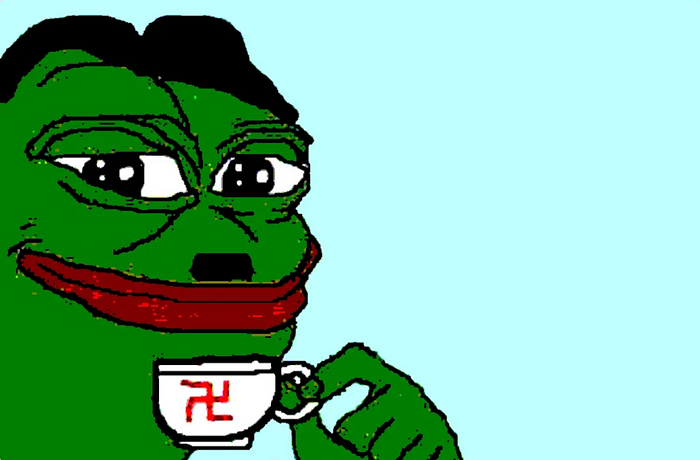Gegen Nazis, Offline and Online

Over the next four years, recognizing certain symbols — especially online — will be more important than ever. However, discussions about these symbols shouldn’t distract from what is happening at the core.
In many scout groups, you earn a badge every year to sew onto your shirt. These usually represent a specific theme or the group you belong to. However, an older boy in my scout group had bought some badges of his own to express his identity. One depicted a fist smashing a swastika with the words “Gegen Nazis” written above it.
As a 12-year-old, I thought “gegen” was a verb, though I didn’t know what it meant. Still, the black-and-white symbol left a strong impression on me. Around that time, I also took my first steps online. There, I encountered many people who could use a symbolic fist. After all, the internet is a wild place.
The World Wide What-The-F***
I grew up on 4chan, joined far-right Telegram groups, spent hours on diverse subreddits back when Reddit was the Wild West, and I’m still on Discord servers I wouldn’t dare open in the office. Not because I align with these (mostly) men, but because understanding how they communicate is important. It allows you to recognize and name things when necessary. Now is one of those times.
Much revolves around “dog whistles.” Far-right and neo-Nazi groups use seemingly innocuous words, numbers, images, or gestures with coded meanings. To outsiders, they appear harmless; for insiders, they signal alignment.
Some of these symbols are now well-known. Pepe the Frog, created in 2004 as a harmless cartoon character, became a mascot for the alt-right nearly a decade later. Cartoonist Matt Furie watched in despair as his creation was co-opted and unsuccessfully tried to reclaim it through the #SavePepe campaign.

Innocent Appearances, Sinister Messages
This tactic of giving innocent symbols a darker meaning isn’t new. In my hometown of Sint-Kruis, there was once a notorious skinhead bar called Moloko. The name, the Russian word for milk, was a nod to the “whitest” drink and a subtle symbol of white power. I still remember my Nigerian friend Marvin diving under the car seat as a “joke” whenever we passed by.
Today, the same idea exists online. The alt-right has claimed the milk emoji, often using it in discussions or sharing images of themselves drinking milk. To outsiders, it’s just milk. To those in the know, it’s a coded message.


The Power of Numbers
Numbers have long been co-opted by extremist groups too. The most infamous are 18 (Adolf Hitler) and 88 (Heil Hitler), based on the positions of the letters A and H in the alphabet. People like Elon Musk frequently reference these numbers, intentionally or not, leading to enthusiastic responses from neo-Nazis.



The number 14 pictured above is another example, referring to David Lane’s “Fourteen Words,” a rallying cry for white supremacists.
Anyone who knows Musk knows that everything he does has a certain symbolism. It’s not by accident that the first cars are named the Tesla S, the Tesla 3, the Tesla X and the Tesla Y: just see what happens if you combine the letters.
In addition, he wanted to delist Tesla at $420 per share, and Twitter at $54.20. After all, April 20 is National Weed Day in the United States. It is also Hitler’s birthday. An innocent joke?

Beyond words and numbers, actions and gestures also carry coded meanings. After Brenton Harrison Tarrant’s Christchurch mosque attack, the media captured him in court making the “OK” hand gesture — another symbol appropriated by far-right groups. To the uninitiated, it was innocuous; to others, it was a chilling salute.
People like Musk often claim plausible deniability, dismissing concerns about these gestures as baseless or conspiratorial. However, their repeated use of symbols and numbers forms a discernible pattern.
The Financial Game
In November 2023, Musk posted a conspiracy theory about Jews on Twitter, sparking backlash and leading advertisers to withdraw. Within days, he visited Israel to meet Prime Minister Netanyahu and business leaders. Photos of this visit are now shared by Musk’s defenders, claiming he “can’t be anti-Semitic.” Such calculated moves highlight the complex interplay between public perception and intent.
Staying Vigilant
The coming years will be challenging, both for casual social media users and for journalists trying to verify content. Here’s what you can do:
- Learn the Symbols: While the list is constantly evolving, recognizing patterns is key.
- Stay Focused: Don’t let these symbols dominate the discourse; they often serve to distract from more pressing issues.
Fasten your seatbelts — it’s going to be a bumpy ride.
